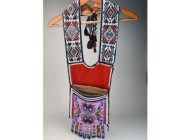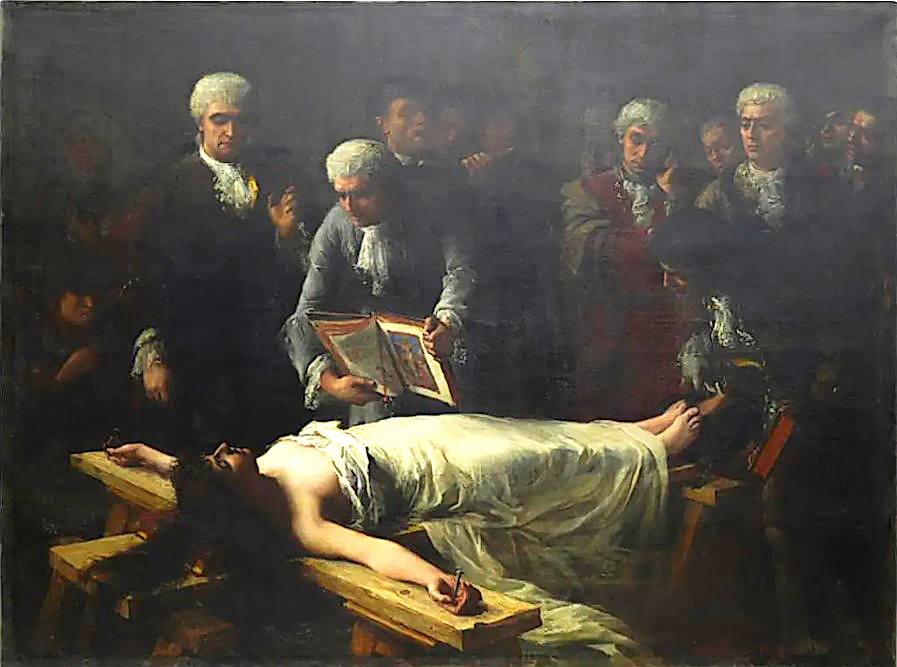
Measuring at a massive 78½ by 106 inches, this Nineteenth Century oil on canvas from Georges Moreau de Tours also won the largest price in the auction at $37,200.
Review by Z.G. Burnett; Images Courtesy Akiba Auction Gallery
DANIA BEACH, FLA. — On August 29, Akiba Galleries hosted the Iconic Collection of Tyen, “a photographer, makeup design director and master of color” who is known for his 30-year career with Christian Dior. Tyen’s Palm Beach residence was designed by architect Addison Mizner (American, 1872-1933), whose combination of Mediterranean and Colonial Revival styles continues to inspire architects and designers today. More than 700 lots from Tyen’s collection reflected this aesthetic with French Gothic Revival furniture, Renaissance furniture, Chinese antiques, religious artifacts and other curious specimens. “The auction was special,” commented co-owner Alexander Anapolsky. “It was an incredibly unique collection which had a little bit of everything.” More than 90 percent of bidders participated online, with 30 percent bidding from the United States and 70 percent from abroad. Some of these were former colleagues of Tyen’s, joining in from France. The auction totaled $768,000 with a 92 percent sell-through rate.
The first listing in the catalog and the highest-achieving lot was a monumental oil on canvas by history painter Georges Moreau de Tours (French, 1848-1901) that was won by a Shanghai bidder for $37,200. Dark in tone and subject, the painting becomes more disturbing the more one examines it. A crucified woman with her breasts exposed is prone and surrounded by a group of men in Eighteenth Century clothing; most stand away and observe while one crouches at her feet and another shows her a bookplate illustration of Jesus’ Crucifixion. The woman, either unconscious or soon to be, does not seem to register the image. De Tours came from a noted medical family that are considered pioneers of alternative forms of psychological treatment, and many of his works display a dramatic dynamism that straddles Romanticism and realism. He was educated at the École des Beaux-Arts after abandoning a career in law, regularly exhibited at the Paris Salon and was awarded the Légion d’honneur in 1892.
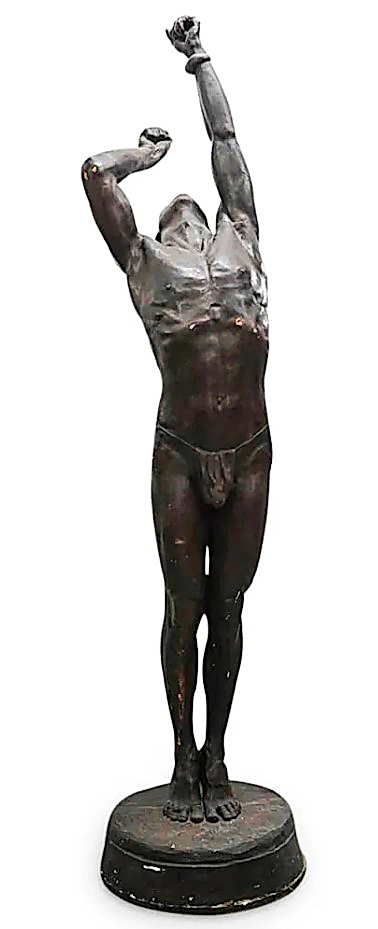
Attributed to artist and explorer Herbert Ward, this life-sized plaster of a West African archer hit the mark at $8,125.
The only other piece of fine art to reach the auction’s top lots was another large-scale work: an 8-foot-tall plaster sculpture of a West African archer attributed to Herbert Ward (British, 1863-1919). Ward traveled extensively in Africa, especially in what was then the Congo, in commercial export positions and later as a member of Henry Morton Stanley’s Emin Pasha Relief Expedition. Ward took extensive notes, illustrations and photographs during his explorations, later creating life-sized, realistic sculptures based on these observations. The style of this plaster matches bronzes of his in the Smithsonian, which also acquired the Ward African Collection of artifacts in 1921. With minor wear throughout, the plaster was bid to $8,125.
Chairs were especially favored by top bidders. Second in the auction overall was a pair of carved wooden Chinese armchairs, showing mother-of-pearl inlay of flowers, foliage and auspicious symbols throughout and two porcelain plaques depicting a riverside village in the back splats. The chairs sold online for $27,500. The next two chairs were in separate lots and came from separate continents, but were strikingly similar in design. First was a Qing dynasty lacquered hard wood armchair, carved with openwork designs of human figures surrounded by floriate motifs, followed by a Nineteenth Century French chinoiserie chair that was also lacquered hard wood and carved with similar imagery. Both were upholstered with gold yellow fabric showing embroidered white flowers, and each of them sold for $10,000.
According to Akiba, some lots of Asian porcelain did much better than expected. Third in the auction was a late Nineteenth Century famille rose porcelain vase showing robed figures in a mountainous setting, a turquoise glaze interior surface and unusual pink figural handles, which went to an internet bidder for $26,500. While this example was only 25 inches high, a pair of famille rose vases stood at 35 inches and were bid to $16,250. These were painted with imperial palace scenes, including courtiers, warriors and servants, and their applied handles were made in the form of chilong and foo dog figures seemingly playing with a flaming pearl.
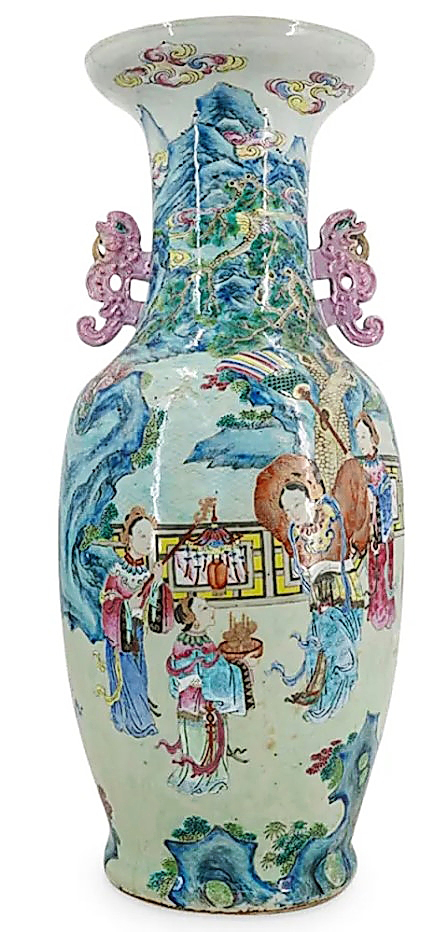
This Nineteenth Century Chinese famille rose vase showed distinctive pink figural handles and a turquoise interior surface, and was third in auction at $26,500.
Two mirrors exceeded expectations. A Nineteenth Century Chinese mirror mounted in an ornately carved wooden frame showing open-work, high relief designs of dragons flanking a Shou (“longevity”) crest, guardian lions playing with embroidered balls and fenghuang birds, surpassed its estimate to $18,750. The other mirror was Syrian and from the late Nineteenth or early Twentieth Century, but also heavily decorated with geometric inlaid mother-of-pearl in floriate patterns. It also exceeded its estimate to close at $7,500.
Tyen’s collection was filled with arcane-looking Gothic Revival objects dating from about the Seventeenth Century, including a Nineteenth Century bronze and wood casket in the form of a cathedral mounted with saints on either side that retained its original key. Its arch and door showed floral trim and polychrome enamel accents that created a stained glass rose window, and the casket closed at $16,250. This echoed a Seventeenth Century French carved wooden altar showing Gothic architectural forms that achieved $6,875. A pair of matching French Gothic iron planters with stands made at the Faure factory in Revin, France, were bid to $9,375. The planters were cast with floral patterns, curly-tailed dragon handles and scrollwork with open-work skirts on the tripod stands.
The auction also featured a selection of large, heavy brown furniture. One such piece was an enormous Eighteenth Century walnut two-tiered sideboard, probably Italian, with elaborate Renaissance Revival relief carvings of lions, mythical beasts and gods throughout. The twin display etagere was supported by a cabinet with two large drawers, three narrow hidden drawers and two double hinged cabinet doors. The sideboard was located offsite for bidding, and sold for $10,000. Another Chinese lot was a Nineteenth to early Twentieth Century console table with a removable top that followed in price at $8,750. The base also showed carved relief motifs with mythical animals, bats, koi fish, elephants and figural oxen “feet.”
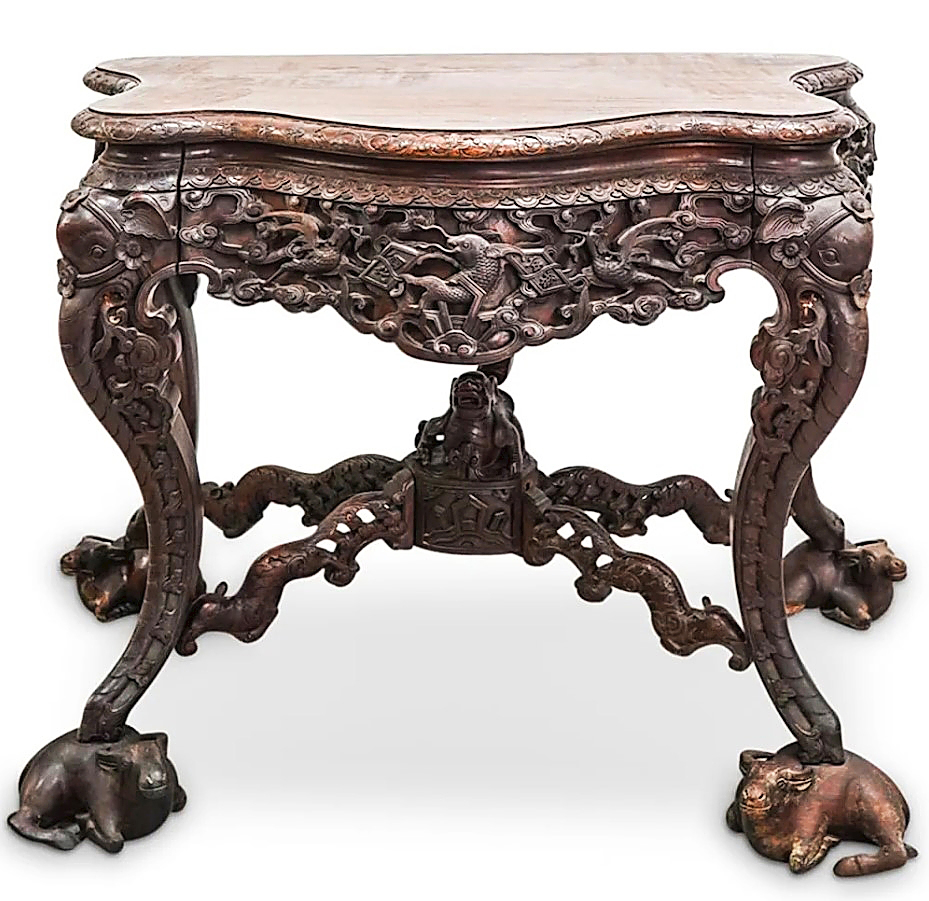
Resting on recumbent oxen “feet,” the surface of this Chinese console table’s base showed a menagerie of carved animals and achieved $8,750.
Mystery and the opportunity for research is always a selling point, and customers for a Nineteenth Century oak easel may have had this in mind when it was bid to $7,500. The 88-inch-high, double-sided easel had an adjustable crank system for securing large canvases, and showed the inscription “Fuss Kaden.” The catalog suggested that it may have been owned by the Polish artist Tadeusz Fuss-Kaden (1914-1985), who signed his paintings with alternating versions of his name such as Tadé, Fuss or Kaden. The Brooklyn Museum, N.Y., has numerous examples of his abstract, atonal works in its collection.
Prices quoted with buyer’s premium as reported by the auction house. Akiba Galleries’ Designer Dream auction will take place on September 19. For information, 305-332-9274 or www.akibagalleries.com.



















